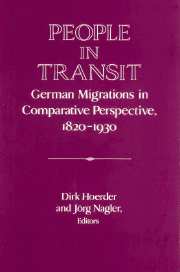Book contents
- Frontmatter
- Introduction
- PART I CONTINUITY AND COMPLEXITY: MIGRATIONS FROM EAST ELBIAN GERMANY AND GALICIAN POLAND
- Part II Internal German Migrations and In-Migrations
- PART III WOMEN'S MIGRATION: LABOR AND MARRIAGE MARKETS
- PART IV ACCULTURATION IN AND RETURN FROM THE UNITED STATES
- 18 Migration Past and Present - The German Experience
- 19 Research on the German Migrations, 1820s to 1930s: A Report on the State of German Scholarship
- Index
18 - Migration Past and Present - The German Experience
Published online by Cambridge University Press: 05 January 2013
- Frontmatter
- Introduction
- PART I CONTINUITY AND COMPLEXITY: MIGRATIONS FROM EAST ELBIAN GERMANY AND GALICIAN POLAND
- Part II Internal German Migrations and In-Migrations
- PART III WOMEN'S MIGRATION: LABOR AND MARRIAGE MARKETS
- PART IV ACCULTURATION IN AND RETURN FROM THE UNITED STATES
- 18 Migration Past and Present - The German Experience
- 19 Research on the German Migrations, 1820s to 1930s: A Report on the State of German Scholarship
- Index
Summary
In united Germany, as in other European countries, the public debate on migration in the early 1990s is haunted by apocalyptic visions of “Fortress Europe,” a continent threatened by new mass migrations. Such visions create or at least strengthen defensive reactions and a widespread attitude of denial among those who view immobile populations as an indication of peace and movement across borders as a sign of danger. This is especially true for united Germany, although the history of the Germans has been strongly influenced by manifold migration movements.
GERMAN CONTINENTAL AND TRANSATLANTIC MIGRATIONS
Early continental emigrants from German-speaking areas were, for example, the ancestors of the Siebenburger Sachsen who went to live in what is now Romania. Their roots reach back to the Kingdom of Hungary in the middle of the twelfth century. They were called “Saxons” by their Hungarian neighbors, but, as a matter of fact, they came mainly from the Rhine and Moselle regions of western Germany. Starting in the eighteenth century other settlers from German-speaking areas followed: the Banater Schwaben from southwestern and central Germany and the Sathmarer Schwaben from Upper Swabia and Baden. Their purpose was to open up, to develop, and to secure through settlement new regions in these areas of eastern Europe. In return, they were offered attractive economic and cultural privileges.
Privileged German settlements also existed for a long time in other parts of southeastern, east-central, and eastern Europe. In Russia, for example, this was true for the German settlements in Wolhynia, along the Black Sea, in the Caucasus, and finally in the Volga region, that is, in what between 1924 and 1941 was called the Autonomous Soviet Republic of the Volga Germans. Until the 1830s, German continental emigration to eastern and southeastern Europe, especially to Russia and the Habsburg countries, was still stronger than transatlantic emigration. In many areas of eastern and southeastern Europe where Germans settled, the German element and its cultural traditions, often centuries old, disappeared only during the century of the world wars. Because of forced resettlements, deportation and expulsion, and cultural repression, and because of the “remigration” of ethnic Germans dreaming of “coming home” to the land of their fathers and, as many of them are reported to have said, living “in the Reich as Germans among Germans,” the German settlements in these areas were dramatically and irrevocably changed.
- Type
- Chapter
- Information
- People in TransitGerman Migrations in Comparative Perspective, 1820–1930, pp. 399 - 412Publisher: Cambridge University PressPrint publication year: 1995



